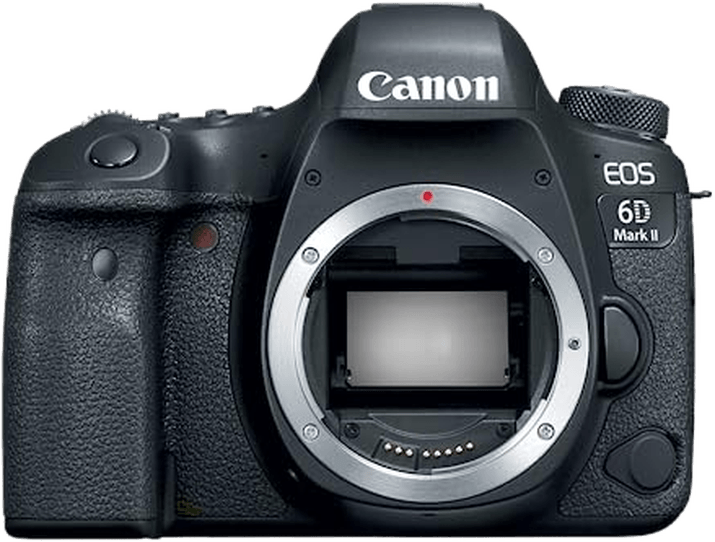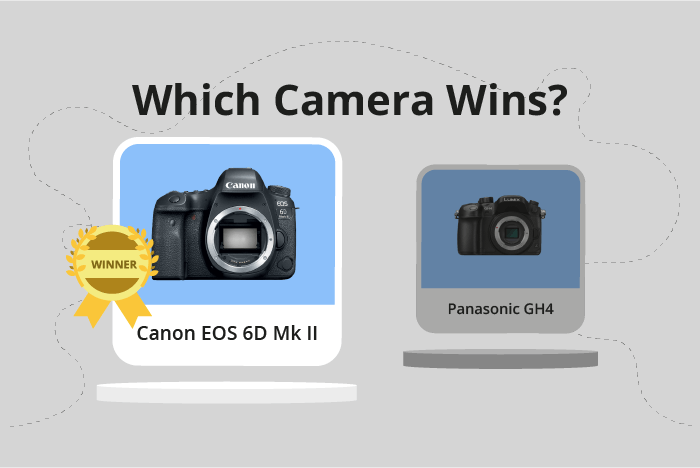Canon EOS 6D Mark II vs Panasonic Lumix DMC-GH4 Comparison
Canon EOS 6D Mark II

Panasonic Lumix DMC-GH4

The Canon EOS 6D Mark II takes the lead with a 71/100 score, while the Panasonic Lumix DMC-GH4 trails behind at 58/100. Both cameras share similarities, such as their announcement and release years, 2017 and 2014 respectively, and their launch prices, $2000 for the Canon and $1700 for the Panasonic.
The Canon EOS 6D Mark II outshines the Panasonic with its DSLR camera type and lighter weight of 453g, making it more portable. Its size dimensions of 144 x 111 x 75mm further contribute to its compactness.
On the other hand, the Panasonic Lumix DMC-GH4 is a mirrorless camera and slightly heavier at 560g. Its size dimensions are 133 x 93 x 84mm. Despite its lower score, the Panasonic still has its merits, such as a lower launch price and a more advanced camera type.
Taking everything into account, the Canon EOS 6D Mark II emerges as the superior choice due to its higher score, DSLR camera type, and lighter weight. However, the Panasonic Lumix DMC-GH4 remains a viable option for those seeking a more budget-friendly and advanced camera type.
Canon EOS 6D Mark II vs Panasonic Lumix DMC-GH4 Overview and Optics
The Canon EOS 6D Mark II outperforms the Panasonic Lumix DMC-GH4 in optics, with a score of 69/100 compared to 52/100. Both cameras share some similarities in specifications: they have CMOS sensors, lack image stabilization, and use similar processors – the Canon with Digic 7 and the Panasonic with Venus Engine IX.
The Canon EOS 6D Mark II has a clear advantage in terms of megapixels, with 26.2 compared to the Panasonic’s 16. This results in higher resolution images, providing more detail and better image quality. The Canon’s full-frame sensor size also contributes to better low-light performance and a shallower depth of field. Additionally, the Canon has a higher DXOMARK sensor score of 85, compared to the Panasonic’s 74, showing that its sensor performs better overall.
However, the Panasonic Lumix DMC-GH4 has a faster shooting speed of 12 frames per second, compared to the Canon’s 6.5. This makes the Panasonic better suited for capturing fast-moving subjects or action photography. The Panasonic also uses a Micro 4/3 lens mount, which offers a wider variety of lenses to choose from and lighter overall camera system.
Considering these points, the Canon EOS 6D Mark II’s superior megapixels, sensor size, and DXOMARK score make it the better choice for photographers prioritizing image quality and low-light performance. On the other hand, the Panasonic Lumix DMC-GH4’s faster shooting speed and versatile lens mount make it a more suitable option for action photography and those seeking a lighter camera system.
Canon EOS 6D Mark II vs Panasonic Lumix DMC-GH4 Video Performance
The Panasonic Lumix DMC-GH4 outperforms the Canon EOS 6D Mark II in video capabilities, with a score of 70/100 compared to the Canon’s 57/100. Both cameras share some common video specifications, such as having built-in time-lapse functionality.
The GH4 excels in its maximum video resolution and dimensions, offering 4K resolution (4096 x 2160) compared to the 6D Mark II’s Full HD (1920 x 1080). This higher resolution allows for more detailed and sharper videos, providing a significant advantage for videographers who require top-quality footage.
However, the Canon 6D Mark II has a higher maximum video frame rate at 30fps, compared to the GH4’s 24fps. This may be beneficial for those who prefer smoother motion in their videos, but the difference in frame rates is not significant enough to outweigh the GH4’s superior resolution.
Taking all of these factors into account, the Panasonic Lumix DMC-GH4 is the better camera for video capabilities due to its higher resolution and overall video score. While the Canon EOS 6D Mark II does have a slightly higher frame rate, it does not compensate for the substantial difference in video quality. Therefore, videographers and content creators should opt for the GH4 for its superior performance in capturing high-quality video footage.
Canon EOS 6D Mark II vs Panasonic Lumix DMC-GH4 Features and Benefits
The Canon EOS 6D Mark II outperforms the Panasonic Lumix DMC-GH4 in features with a score of 83/100 compared to the GH4’s 70/100. Both cameras share a 3-inch screen size, touchscreen capabilities, flip screen, and WIFI connectivity. However, there are some key differences that make the 6D Mark II a better option in terms of features.
The 6D Mark II has a slightly higher screen resolution at 1,040,000 dots, compared to the GH4’s 1,036,000 dots. This provides a marginally clearer and sharper display. Additionally, the 6D Mark II includes GPS and Bluetooth capabilities, which the GH4 lacks. GPS allows for geotagging of images, while Bluetooth provides seamless connectivity with other devices.
While the Canon EOS 6D Mark II has better features overall, there are some aspects where the Panasonic Lumix DMC-GH4 may be considered superior. However, based on the given specifications, there are no specific advantages for the GH4 in this comparison.
Taking into consideration the higher feature score and additional GPS and Bluetooth capabilities, the Canon EOS 6D Mark II is the clear winner in this comparison. The shared specifications such as screen size, touchscreen, flip screen, and WIFI connectivity make both cameras suitable for various photography needs. However, the 6D Mark II’s additional features provide an edge over the Panasonic Lumix DMC-GH4, making it the better choice for those prioritizing advanced features in their camera selection.
Canon EOS 6D Mark II vs Panasonic Lumix DMC-GH4 Storage and Battery
The Panasonic Lumix DMC-GH4 outperforms the Canon EOS 6D Mark II in storage and battery with a score of 60/100, compared to Canon’s 45/100. Both cameras accept SD, SDHC, and SDXC memory cards, with the GH4 having an advantage of two memory card slots, while the 6D Mark II has only one. This allows for more storage capacity and flexibility for the GH4 users.
In terms of battery life, the Canon EOS 6D Mark II takes the lead with 1200 shots per charge, significantly more than the GH4’s 500 shots. However, both cameras use different battery types: the 6D Mark II uses the LP-E6N, while the GH4 uses the DMW-BLF19. Neither camera offers USB charging.
Considering these points, the GH4 has an advantage in storage with its dual memory card slots, while the 6D Mark II excels in battery life. Both cameras have their strengths and cater to different user preferences.
Canon EOS 6D Mark II vs Panasonic Lumix DMC-GH4 – Our Verdict
Are you still undecided about which camera is right for you? Have a look at these popular comparisons that feature the Canon EOS 6D Mark II or the Panasonic Lumix DMC-GH4:

